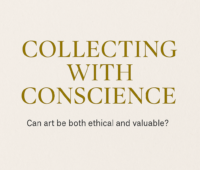
Collecting with Conscience: Can Art Be Both Ethical and Valuable?
9 August 2025
Introduction: The New Currency of Integrity
In the gilded halls of the art market, value has long been measured in price tags and prestige. Yet, a quiet but profound shift is underway. Today’s most discerning collectors are asking a different question: Can I build a meaningful collection without compromising my integrity?
This is no small challenge. The art world—particularly in the realms of Modern, Post-War, and Contemporary art—is rife with murky provenance trails, market manipulation, and the uncomfortable truth that not every beautiful object has an equally beautiful story. As a long-time art adviser, I’ve seen first-hand that ethical collecting is not only possible—it can enhance both the emotional and financial value of a collection. But it requires intention, discipline, and a willingness to look beyond the gloss.
Provenance: The Skeleton in the Gallery
The ethical life of a collection begins with provenance—the documented history of ownership. A painting by a blue-chip name such as Picasso or Giacometti may dazzle at first glance, but without airtight provenance, its beauty is shadowed by doubt.
World War II looted art, stolen cultural heritage, and dubious private sales still haunt the secondary market. The due diligence process—tracing exhibition history, consulting archives, engaging independent researchers—must be non-negotiable. It’s not just about avoiding legal complications; it’s about respecting the narrative and dignity of the work.
In my experience, works with unimpeachable provenance tend to command greater stability in value. Ethical transparency becomes an asset—one that speaks to both the intellect and the wallet.
Representation: Whose Story Gets Told?
An ethical collection is not just about what you avoid; it’s about what you champion. Representation—of cultures, genders, geographies, and voices—is central to this. The art market has historically amplified a narrow group of artists, often at the expense of equally compelling but overlooked talent.
Supporting underrepresented artists—be they women of the Abstract Expressionist movement overshadowed by their male peers, or emerging voices from regions often sidelined in Western art history—can yield collections of remarkable depth and authenticity. This is not charity. Many of these works, once recognised, see significant appreciation as the market catches up to cultural reality.
Emotional Resonance: Art Beyond the Transaction
Collecting ethically also means asking: Does this work matter to me beyond its potential resale? A collection built solely on speculation will always be at the mercy of market trends. But works chosen for their emotional and intellectual resonance create a more enduring relationship between the collector and the art.
When advising clients, I often ask them to spend time with a work before committing. How does it change in different light? How does it speak to their personal history or worldview? Art chosen with genuine connection retains its relevance—regardless of whether the market is in boom or bust.
The Myth of the Trade-off: Ethics vs. Value
There’s a persistent misconception that ethics and profitability are mutually exclusive. In reality, works with clean provenance, thoughtful representation, and strong emotional resonance are more likely to retain or increase in value over time.
Consider the market for Yayoi Kusama. Her early Infinity Net paintings, acquired by collectors who understood both her groundbreaking vision and her place in art history, have seen exponential growth in value—without any ethical compromises. Similarly, Claude Monet’s water lilies are revered not just for their beauty but for their unbroken provenance and central role in Impressionist history.
Ethics, in other words, can be a multiplier, not a constraint.
Strategies for Building an Ethical, Valuable Collection
- Demand Documentation – Require detailed provenance records, condition reports, and authenticity certificates.
- Work with Trusted Advisers – Independent advisers with no vested interest in a sale can guide you away from risky acquisitions.
- Champion the Overlooked – Seek out galleries, fairs, and exhibitions that prioritise underrepresented artists.
- Think Generationally – Build a collection that you would be proud to pass on—not just one you can profit from.
- Engage with Institutions – Loan works for exhibitions, participate in educational initiatives, and contribute to the public discourse on art.
Conclusion: The Legacy You Leave
An art collection is more than a set of objects—it’s a narrative. It tells the story of your values, your vision, and your time in history. In an age where transparency, diversity, and sustainability are increasingly demanded in every industry, the art world is no exception.
Collecting with conscience does not mean sacrificing value. It means creating value—cultural, emotional, and financial—in a way that stands the test of time. Because when your collection’s integrity is as enduring as its aesthetic, you haven’t just built wealth—you’ve built a legacy.
Daniel Turriani

Leave a Reply